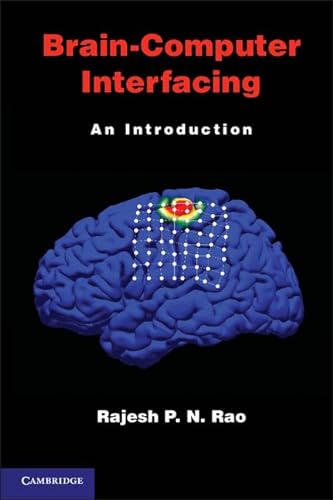brain computer interfacing introduction von rao rajesh (4 Ergebnisse)
Suchfilter
Produktart
- Alle Product Types
- Bücher (4)
- Magazine & Zeitschriften (Keine weiteren Ergebnisse entsprechen dieser Verfeinerung)
- Comics (Keine weiteren Ergebnisse entsprechen dieser Verfeinerung)
- Noten (Keine weiteren Ergebnisse entsprechen dieser Verfeinerung)
- Kunst, Grafik & Poster (Keine weiteren Ergebnisse entsprechen dieser Verfeinerung)
- Fotografien (Keine weiteren Ergebnisse entsprechen dieser Verfeinerung)
- Karten (Keine weiteren Ergebnisse entsprechen dieser Verfeinerung)
- Manuskripte & Papierantiquitäten (Keine weiteren Ergebnisse entsprechen dieser Verfeinerung)
Zustand Mehr dazu
- Neu (2)
- Wie Neu, Sehr Gut oder Gut Bis Sehr Gut (1)
- Gut oder Befriedigend (1)
- Ausreichend oder Schlecht (Keine weiteren Ergebnisse entsprechen dieser Verfeinerung)
- Wie beschrieben (Keine weiteren Ergebnisse entsprechen dieser Verfeinerung)
Einband
Weitere Eigenschaften
- Erstausgabe (Keine weiteren Ergebnisse entsprechen dieser Verfeinerung)
- Signiert (Keine weiteren Ergebnisse entsprechen dieser Verfeinerung)
- Schutzumschlag (Keine weiteren Ergebnisse entsprechen dieser Verfeinerung)
- Angebotsfoto (2)
Sprache (1)
Preis
- Beliebiger Preis
- Weniger als EUR 20 (Keine weiteren Ergebnisse entsprechen dieser Verfeinerung)
- EUR 20 bis EUR 45
- Mehr als EUR 45
Gratisversand
- Kostenloser Versand nach USA (Keine weiteren Ergebnisse entsprechen dieser Verfeinerung)
Land des Verkäufers
Verkäuferbewertung
-
Brain-Computer Interfacing: An Introduction
Sprache: Englisch
Verlag: Cambridge University Press, 2013
ISBN 10: 0521769418 ISBN 13: 9780521769419
Anbieter: WorldofBooks, Goring-By-Sea, WS, Vereinigtes Königreich
EUR 21,76
EUR 6,39 shipping
Versand von Vereinigtes Königreich nach USAAnzahl: 1 verfügbar
In den WarenkorbPaperback. Zustand: Very Good. The book has been read, but is in excellent condition. Pages are intact and not marred by notes or highlighting. The spine remains undamaged.
-
Brain-Computer Interfacing: An Introduction
Sprache: Englisch
Verlag: Cambridge University Press, 2019
ISBN 10: 1108708013 ISBN 13: 9781108708012
Anbieter: Majestic Books, Hounslow, Vereinigtes Königreich
EUR 55,23
EUR 7,42 shipping
Versand von Vereinigtes Königreich nach USAAnzahl: 1 verfügbar
In den WarenkorbZustand: New.
-
Brain-Computer Interfacing: An Introduction : An Introduction
Anbieter: AHA-BUCH GmbH, Einbeck, Deutschland
Gebundene Ausgabe. Zustand: Sehr gut. Gebraucht - Sehr gut SG - leichte Beschädigungen oder Verschmutzungen, ungelesenes Mängelexemplar, gestempelt - The idea of interfacing minds with machines has long captured the human imagination. Recent advances in neuroscience and engineering are making this a reality, opening the door to restoration and augmentation of human physical and mental capabilities. Medical applications such as cochlear implants for the deaf and neurally controlled prosthetic limbs for the paralyzed are becoming almost commonplace. Brain-computer interfaces (BCIs) are also increasingly being used in security, lie detection, alertness monitoring, telepresence, gaming, education, art, and human augmentation. This introduction to the field is designed as a textbook for upper-level undergraduate and first-year graduate courses in neural engineering or brain-computer interfacing for students from a wide range of disciplines. It can also be used for self-study and as a reference by neuroscientists, computer scientists, engineers, and medical practitioners. Key features include questions and exercises in each chapter and a supporting website.
-
Brain-Computer Interfacing : An Introduction
Sprache: Englisch
Verlag: Cambridge University Press Sep 2013, 2013
ISBN 10: 0521769418 ISBN 13: 9780521769419
Anbieter: AHA-BUCH GmbH, Einbeck, Deutschland
Buch. Zustand: Neu. Neuware - The idea of interfacing minds with machines has long captured the human imagination. Recent advances in neuroscience and engineering are making this a reality, opening the door to restoration and augmentation of human physical and mental capabilities. Medical applications such as cochlear implants for the deaf and neurally controlled prosthetic limbs for the paralyzed are becoming almost commonplace. Brain-computer interfaces (BCIs) are also increasingly being used in security, lie detection, alertness monitoring, telepresence, gaming, education, art, and human augmentation. This introduction to the field is designed as a textbook for upper-level undergraduate and first-year graduate courses in neural engineering or brain-computer interfacing for students from a wide range of disciplines. It can also be used for self-study and as a reference by neuroscientists, computer scientists, engineers, and medical practitioners. Key features include questions and exercises in each chapter and a supporting website.





